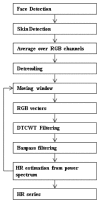Non-contact estimation of heart rate and oxygen saturation using ambient light
- PMID: 25657877
- PMCID: PMC4317113
- DOI: 10.1364/BOE.6.000086
Non-contact estimation of heart rate and oxygen saturation using ambient light
Abstract
We propose a robust method for automated computation of heart rate (HR) from digital color video recordings of the human face. In order to extract photoplethysmographic signals, two orthogonal vectors of RGB color space are used. We used a dual tree complex wavelet transform based denoising algorithm to reduce artifacts (e.g. artificial lighting, movement, etc.). Most of the previous work on skin color based HR estimation performed experiments with healthy volunteers and focused to solve motion artifacts. In addition to healthy volunteers we performed experiments with child patients in pediatric intensive care units. In order to investigate the possible factors that affect the non-contact HR monitoring in a clinical environment, we studied the relation between hemoglobin levels and HR estimation errors. Low hemoglobin causes underestimation of HR. Nevertheless, we conclude that our method can provide acceptable accuracy to estimate mean HR of patients in a clinical environment, where the measurements can be performed remotely. In addition to mean heart rate estimation, we performed experiments to estimate oxygen saturation. We observed strong correlations between our SpO2 estimations and the commercial oximeter readings.
Keywords: (100.2960) Image analysis; (100.7410) Wavelets; (170.3880) Medical and biological imaging.
Figures









Similar articles
-
Non-Contact Oxygen Saturation Measurement Using YCgCr Color Space with an RGB Camera.Sensors (Basel). 2021 Sep 12;21(18):6120. doi: 10.3390/s21186120. Sensors (Basel). 2021. PMID: 34577326 Free PMC article.
-
Self-adaptive signal separation for non-contact heart rate estimation from facial video in realistic environments.Physiol Meas. 2018 Jun 28;39(6):06NT01. doi: 10.1088/1361-6579/aaca83. Physiol Meas. 2018. PMID: 29869991
-
Continuous non-contact vital sign monitoring in neonatal intensive care unit.Healthc Technol Lett. 2014 Sep 23;1(3):87-91. doi: 10.1049/htl.2014.0077. eCollection 2014 Sep. Healthc Technol Lett. 2014. PMID: 26609384 Free PMC article.
-
Effects of motion, ambient light, and hypoperfusion on pulse oximeter function.J Clin Anesth. 1997 May;9(3):179-83. doi: 10.1016/s0952-8180(97)00039-1. J Clin Anesth. 1997. PMID: 9172022 Clinical Trial.
-
Availability and performance of image-based, non-contact methods of monitoring heart rate, blood pressure, respiratory rate, and oxygen saturation: a systematic review.Physiol Meas. 2019 Jul 3;40(6):06TR01. doi: 10.1088/1361-6579/ab1f1d. Physiol Meas. 2019. PMID: 31051494
Cited by
-
Enhanced Contactless Vital Sign Estimation from Real-Time Multimodal 3D Image Data.J Imaging. 2020 Nov 12;6(11):123. doi: 10.3390/jimaging6110123. J Imaging. 2020. PMID: 34460567 Free PMC article.
-
New principle for measuring arterial blood oxygenation, enabling motion-robust remote monitoring.Sci Rep. 2016 Dec 7;6:38609. doi: 10.1038/srep38609. Sci Rep. 2016. PMID: 27924930 Free PMC article.
-
Clinical applications of contactless photoplethysmography for vital signs monitoring in pediatrics: A systematic review and meta-analysis.J Clin Transl Sci. 2023 May 25;7(1):e144. doi: 10.1017/cts.2023.557. eCollection 2023. J Clin Transl Sci. 2023. PMID: 37396820 Free PMC article. Review.
-
Contactless blood oxygen estimation from face videos: A multi-model fusion method based on deep learning.Biomed Signal Process Control. 2023 Mar;81:104487. doi: 10.1016/j.bspc.2022.104487. Epub 2022 Dec 10. Biomed Signal Process Control. 2023. PMID: 36530216 Free PMC article.
-
Validation study of the use of the HRVCAM software for the evaluation of heart rate and heart rate variability at rest.Eur Heart J Digit Health. 2021 Nov 29;3(1):98-104. doi: 10.1093/ehjdh/ztab099. eCollection 2022 Mar. Eur Heart J Digit Health. 2021. PMID: 36713991 Free PMC article.
References
-
- Camm A. J., Malik M., Bigger J. T., Breithardt G., Cerutti S., Cohen R. J., Coumel P., Fallen E. L., Kennedy H. L., Kleiger R. E., Lombardi F., Malliani A., Moss A. J., Rottman J. N., Schmidt G., Schwartz P. J., Singer D. H., Task Force of the European Society of Cardiology and the North American Society of Pacing and Electrophysiology , “Heart rate variability. Standards of measurement, physiological interpretation, and clinical use,” Eur. Heart J. 17(3), 354–381 (1996).10.1093/oxfordjournals.eurheartj.a014868 - DOI - PubMed
LinkOut - more resources
Full Text Sources
Other Literature Sources
